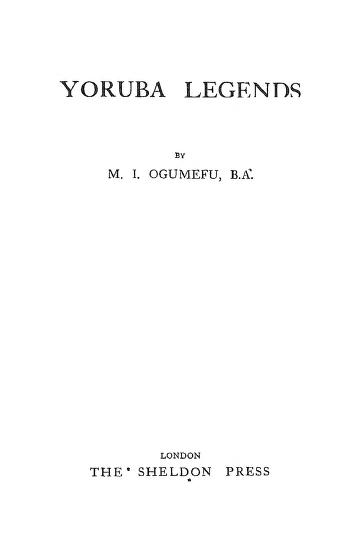Title of the work
Country of the First Edition
Country/countries of popularity
Original Language
First Edition Details
M. I. Ogumefu, “The Twin Brothers” in Yoruba Legends, London: The Sheldon Press, 1929, 33–36.
ISBN
Available Onllne
The Twin Brothers (accessed: August 2, 2021)
Genre
Folk tales
Legends
Target Audience
Crossover
Cover

Retrieved from Internet Archive (accessed: August 2, 2021)
Author of the Entry:
Chester Mbangchia, University of Yaoundé 1, mbangchia25@gmail.com
Peer-reviewer of the Entry:
Daniel A. Nkemleke, University of Yaoundé 1, nkemlekedan@yahoo.com
Susan Deacy, University of Roehampton, s.deacy@roehampton.ac.uk
Marta Pszczolińska, University of Warsaw, m.pszczolinska@al.uw.edu.pl

Margaret I. Ogumefu (Baumann)
[Marguerite Lees] , 1905 - 1990
(Author)
M. I. Ogumefu (23 Apr 1905–16 Feb 1990) was born in Manchester, Lancashire, England as Margaret Irene Sarah Baumann. She married Michael Gladstone Ogumefu, originally from Lagos, Nigeria. After his death in 1927, she published two books collecting Nigerian folk and fairy tales: both in London in 1929: Ajapa the Tortoise as Margaret I. Bauman, and Yoruba Legends as M. I. Ogumefu. Under this name, she is currently considered a "single-book author". In the 1950s–1980s, she also published over 40 books of fiction as Marguerite Lees. Her books were mostly romantic novels set in hospitals with nurse protagonists and were published in the series Harlequin Romance.
Source:
British women writers of fiction (accessed: April 30, 2021),
ancestry.fr (Baumann family; Lees Family Tree),
Marguerite Lees (accessed: April 30, 2021).
Bio prepared by Marta Pszczolińska, University of Warsaw, m.pszczolinska@al.uw.edu.pl
Summary
King Ajaka, a Yoruba King had twins with his wife and he refused to kill the kids and their mother, though their tradition prohibited the keeping of twins. Rather, he sent one of his nobles to keep them in the forest. The twins grew up in the forest. They were identical in a way that when one started a phrase, the other completed it.
Years passed by and their mother grew old. Before she died, she revealed their history to them. This angered the twins and they wished that the laws of their community were changed, so that they could reign. Soon after, they heard that the King, their father had died and there was the need for the enthronement of a new King. One of them had to succeed the throne but they were unaware which of them. After the two had cast stones to decipher the successor and the lot had fallen on the younger twin, they planned that he would ascend the throne and later invite his brother for them to both manage their wealth. When the younger twin arrived in the village, with the consent of the villagers, he became King. Thereafter, as promised, he invited his brother and the two happily managed their wealth while he treated his brother with honour.
The older brother soon became envious of the younger one. One day, during their walk by the river, he pushed his brother, the King, into it, drowning him. He returned to the village and informed the people that his brother was tired of rulership and left the village, daring him to rule, if he could. Since the villagers did not see the King, they accepted and enthroned the older brother.
Some time passed and one day, as he passed by the river where he drowned his brother, fish rose to the surface and sang, “Your brother lies here, / Your brother lies here.” Filled with fright, he used a sharp stone and killed the fish. On his second passage there, this time with his notables, the waves of the river rose and sang the same song. Out of curiosity, the notables stopped to listen and looking into the water, they saw the late King’s corpse. They confronted the older twin and he confessed his killing of the King. Filled with guilt, he drank poison and died.
Analysis
The tale of the twin brothers shows the intricate reception and co-dependence of twins in Africa. In ancient times twins were an abomination for communities and they were either killed along with their mother or banished. In Yoruba culture, as the tale indicates, the twins were supposed to be killed. This community believed that multiple births violated the boundaries of childbearing and needed eradication of its creator (the mother) and the creation (the twins) to purify the land that they had contaminated. The people’s law against twins, on the one hand, begs the question of what humanity consists of. The King’s refusal to heed tradition and kill the twins and their mother, on the other hand, shows his defiling and betrayal of tradition and his desire to save his kind – a drift in paradigm in cultural expectations.
The older brother in the story brings calamity upon himself by killing his brother and seizing the throne. The hatred for a brother in the Yoruba tale shares semblances with the rift between Labongo and Gipir in the east African myth dramatized in Tom Omara’s The Exodus. The legend, thus, shows the awe of twins who are invariably complex yet cohere in many traits. The story emphasises that divine retribution awaits anyone who commits a grievous crime like killing.
Further Reading
Olaleye-Oruene, Taiyo, “Cultic powers of Yoruba twins”, Acta Geneticae Medicae et Gemellologiae 32 (1983): 221–228.
Oruene, Taiwo, "Magical Powers of Twins in the Socio-religious Beliefs of the Yoruba", Folklore 96.2 (1985): 208–216.


